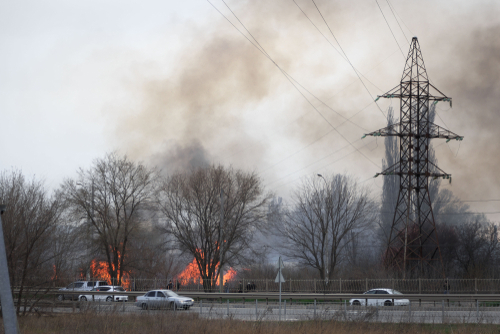Electric utilities eye wildfire security and grid resiliency

WASHINGTON – Electric utility executives celebrated a decade-long turn-around in strategy that has succeeded in reducing emissions, expanding efficiency and moving towards renewable sources during the United States Energy Association’s annual State of the Energy Industry Forum Thursday.
With major accomplishments in carbon reduction, the focus is shifting toward resiliency, the fight against disruptions due to natural disasters, cyber and terrorist attacks, Tom Kuhn, the president of the Edison Electric Institute, told the gathering of 300 utility executives and trade group officials at the National Press Club.
“We used to say reliability is the total priority, is the number one priority, and it still is, but the definition of reliability we’ve found is how the system works on a day-to-day basis,” Kuhn said. “But the resiliency is where we’re focused a lot now, which is to say, ‘What happens when you have extraordinary events and it’s not an ordinary situation; where you have the storms like Sandy and Maria; where you have tornadoes; where you have wildfires.’ Well, our business the last decade is we’ve had to really harden ourselves with the idea that we have to make the system a lot stronger.”
The strategy has prompted EEI, the association that represents all U.S. investor-owned electric companies, to form partnerships with the federal government to forecast and respond to storms, allocate manpower in response, and to protect against potential cyberattacks, Kuhn said.
He announced that as part of EEI’s annual meeting with government agencies in Washington next week, EEI’s Electricity Subsector Coordinating Council, a group of utility and trade group executives, will meet with additional federal agency representatives at the U.S. Department of Agriculture, U.S. Fire Administration, and departments of Interior and Energy, to discuss disaster planning for forest fires. “This is an industrywide issue,” he said. “We need to get in front of the situation … I think we’re going to have a situation in the future where we’re going to be moving resources in a major way to deal with wildfires in the future.”
Kuhn told Daily Energy Insider after his speech among the issues to be discussed are the possibility of more aggressive management of fires on federal lands, ways to use technology to predict, report and plan for fires, and protect the electric grid during wildfires. “We’ve seen what’s happened in wildfire areas in Australia and this is an example of what can happen,” he said.
Next week’s meeting, which will occur the day before the Council’s annual meeting with the National Security Agency, Department of Homeland Security and the FBI, is an outgrowth of EEI’s efforts that have spawned a CEO wildfire task force in the past year, he said.
Kuhn told attendees electric utilities over the past decade have become “much cleaner, much smarter and much stronger,” which has allowed them to become more customer-focused.
Ten years ago, he noted, the industry was “in the crosshairs” of legislators and regulators who wanted it to be cleaner and more efficient. The electric industry has responded by achieving both these goals while keeping rate increases below the rate of inflation, Kuhn said. “We have to continue to evolve to do these things,” he stated.
He spoke of states’ and cities’ goals of carbon-free electric power by 2030 and later, adding “the commitment and vision is there, we’re going to continue to work towards that.”
“There’s a transformation going on in this industry,” said Kuhn.
Kuhn reminded attendees that the industry is nonpartisan, and will remain so, no matter which party wins the elections next fall. “No matter what happens Nov. 4, 2020, the electric power industry will have the same focus and the same vision as we had the night before,” he stated.
Also speaking at the forum were:
Rich Nolan, president and CEO of the National Mining Association, who said coal continues to be a major energy source, with hundreds of coal plants planned around the world. “Coal will be a dominant source of energy on the world stage for the foreseeable future.”
Abigail Ross Hopper, president and CEO of the Solar Energy Industries Association, said Trump administration tariffs on foreign solar panels have cost American jobs and raised the cost of solar energy in the United States. “Tariffs will continue to be a speed bump as long as they’re in place.”
Tom Kiernan, CEO of the American Wind Energy Association, said more wind farms will soon be developed offshore in the United States. He said his group could support a carbon tax and/or dividends under the right circumstances. “We will work with legislators to see what makes good sense.”
Julia Hamm, president and CEO of the Smart Electric Power Alliance, said, “the pace of change (in the electricity market) is expediting.” She said a major shift in smart electric power will be towards cleaner transportation. “We need to start preparing now.” Hamm added, “We’re going to need regulatory innovation to not impede our ability to innovate and move forward.”
Maria Korsnick, president and CEO of the Nuclear Energy Institute, said nuclear power will continue to have a major place in the move toward greener energy and predicted the 2020s will be “an exciting decade for nuclear.” She said fears of nuclear waste are overblown because 95 percent of existing nuclear waste will eventually be recyclable so reactors will be using that waste for fuel in the future. “In the meantime, it is safe where it is.”
